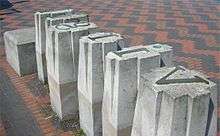John Baskerville
| John Baskerville | |
|---|---|
_by_James_Millar.jpeg) Baskerville in later life, oil on canvas by James Millar. | |
| Born |
28 January 1707 (baptised) Wolverley, England |
| Died |
8 January 1775 (age 68) Easy Hill, Birmingham, England |
| Monuments | Industry and Genius |
| Occupation | Manufacturer, printer and type designer |
John Baskerville (baptised 28 January 1706 – 8 January 1775) was an English businessman, in areas including japanning and papier-mâché, but he is best remembered as a printer and type designer.[1][2][3]
Life
Baskerville was born in the village of Wolverley, near Kidderminster in Worcestershire and baptised on 28 January at Wolverley church. At the time of his birth this was considered the year 1706; it would now be considered early 1707.[4][5] Baskerville established an early career teaching handwriting and is known to have offered his services cutting gravestones (a demonstration slab by him survives in the Library of Birmingham) before making a considerable fortune from the manufacture of lacquerwork items (japanning).
He practised as a printer in Birmingham, England. Baskerville was a member of the Royal Society of Arts, and an associate of some of the members of the Lunar Society. He directed his punchcutter, John Handy, in the design of many typefaces of broadly similar appearance. In 1757, Baskerville published a remarkable quarto edition of Virgil on wove paper, using his own type. It took three years to complete, but it made such an impact that he was appointed printer to the University of Cambridge the following year.[6]

John Baskerville printed works for the University of Cambridge in 1758 and, although an atheist,[7] printed a splendid folio Bible in 1763. His typefaces were greatly admired by Benjamin Franklin, a fellow printer.[8] Baskerville's work was criticised by jealous competitors and soon fell out of favour, but since the 1920s many new fonts have been released by Linotype, Monotype, and other type foundries – revivals of his work and mostly called 'Baskerville'. Emigre released a popular revival of this typeface in 1996 called Mrs Eaves, named for Baskerville's wife, Sarah Eaves.[9] Baskerville's most notable typeface Baskerville represents the peak of transitional type face and bridges the gap between Old Style and Modern type design.[10][11][12]
Baskerville also was responsible for significant innovations in printing, paper and ink production. He worked with paper maker James Whatman to produce a smoother whiter paper which showcased his strong black type[13]. Baskerville also pioneered a completely new style of typography adding wide margins and leading between each line.[14]
Death and interments
Baskerville died in January 1775 at his home, Easy Hill. He requested that his body be placed
in a Conical Building in my own premises Hearetofore used as a mill which I have lately Raised Higher and painted and in a vault which I have prepared for It. This Doubtless to many may appear a Whim perhaps It is so—But it is a whim for many years Resolve'd upon, as I have a Hearty Contempt for all Superstition the Farce of a Consecrated Ground the Irish Barbarism of Sure and Certain Hopes &c I also consider Revelation as it is call'd Exclusive of the Scraps of Morality casually Intermixt with It to be the most Impudent Abuse of Common Sense which Ever was Invented to Befool Mankind.[1]
However, in 1821 a canal was built through the land and his body was placed on show by the landowner until Baskerville's family and friends arranged to have it moved to the crypt of Christ Church, Birmingham. Christ Church was demolished in 1897 so his remains were then moved, with other bodies from the crypt, to consecrated catacombs at Warstone Lane Cemetery.[7] In 1963 a petition was presented to Bimingham City Council requesting that he be reburied in unconsecrated ground according to his wishes.[15]
Baskerville House was built on the grounds of Easy Hill. In 1947, BBC radio broadcast a radio play about his burial, named Hic Jacet: or The Corpse in the Crescent by Neville Brendon Watts. The original recording was not preserved but a performance was staged by students at the Birmingham School of Acting in 2013 at the Typographic Hub Centre of Birmingham City University.[16][17]
Commemoration

A Portland stone sculpture of the Baskerville typeface, Industry and Genius, in his honour stands in front of Baskerville House in Centenary Square, Birmingham. It was created by local artist David Patten.[18]
Gallery
Some examples of volumes published by Baskerville.

 John Milton's Paradise Lost (1758)
John Milton's Paradise Lost (1758) Volume One of The works of Joseph Addison (1761)
Volume One of The works of Joseph Addison (1761) Title page of Baskerville's 1763 Bible
Title page of Baskerville's 1763 Bible- The 1766 translation of Virgil into English, by Robert Andrews
See also
References
- Citations
- 1 2 Mosley, James (2004). "Baskerville, John (1706–1775)". Oxford Dictionary of National Biography. Oxford University Press. Retrieved 17 Nov 2014.
- ↑ Benton, Josiah (2014). John Baskerville : type-founder and printer, 1706 -1775. [S.l.]: Cambridge Univ Press. ISBN 9781108076227. Retrieved 10 December 2015.
- ↑ Robert Dodsley (22 January 2004). The Correspondence of Robert Dodsley: 1733-1764. Cambridge University Press. pp. 144–6. ISBN 978-0-521-52208-3.
- ↑ "John Baskerville: Timeline". Typographic Hub. Birmingham City University. Retrieved 3 February 2018.
- ↑ Mosley, James (1963). "English Vernacular". Motif. 11: 3–56.
- ↑ Lyons, Martyn. (2011). Books: A living history. Los Angeles, CA: Getty Publications. pp. 111
- 1 2 "Printer's Reburial Demanded". The Times. March 9, 1963. p. 6.
- ↑ Benjamin Franklin (1840). The Works of Benjamin Franklin: Containing Several Political and Historical Tracts Not Included in Any Former Edition, and Many Letters, Official and Private, Not Hitherto Published; with Notes and a Life of the Author. Hillard, Gray. pp. 212–5.
- ↑ "Baskerville revisited". Print. 50: 28D. 1996.
- ↑ Meggs, Philip B., Purvis, Alston W. "Graphic Design and the Industrial Revolution" History of Graphic Design. Hoboken, N.J: Wiley, 2006. p.122.
- ↑ Johnson, Alfred F. (1930). "The Evolution of the Modern-Face Roman". The Library. s4-XI (3): 353–377. doi:10.1093/library/s4-XI.3.353.
- ↑ Eliason, Craig (October 2015). ""Transitional" Typefaces: The History of a Typefounding Classification". Design Issues. 31 (4): 30–43. doi:10.1162/DESI_a_00349.
- ↑ Baker, Anne Pimlott (2004-09-23). Whatman, James (1702–1759), paper maker. Oxford Dictionary of National Biography. Oxford University Press. doi:10.1093/ref:odnb/40776.
- ↑ Sutton, James; Sutton, Alan (1988). An Atlas of Typeforms. Wordsworth Editions. p. 59. ISBN 1-85326-911-5.
- ↑ "Petition Presented For Printer's Reburial". The Times. 13 Mar 1963. p. 5.
- ↑ "Baskerville Society: Hic Jacet or The Corpse in the Crescent". Typographic Hub. Retrieved 9 October 2017.
- ↑ "A rare revival of a macabre story". Birmingham Mail. Retrieved 9 October 2017.
- ↑ "Industry and Genius". Archived from the original on 29 August 2008. Retrieved 23 July 2009.
- Bibliography
- Benton, Josiah Henry (1914). John Baskerville: Type-founder and Printer, 1706–1775. Boston: The Merrymount Press.
- Gaskell, Philip (1973). John Baskerville: A Bibliography. Paul P. B. Minet. ISBN 0-85609-029-8.
- Pardoe, Frank Ernest (1975). John Baskerville of Birmingham Letter-Founder and Printer. London: Frederick Muller, Ltd.

- ARCHER-PARRÉ, Caroline & Malcom DICK (Editors), JOHN BASKERVILLE: Art and industry of the enlightenment. Liverpool: Liverpool University Press, 2017. 8vo, (240x160mm), xviii,269p
External links
- Works by John Baskerville at Open Library
- Birmingham City Council page on Industry and Genius (includes picture)
- Revolutionary Players website
- Baskerville the Animated Movie
- Some typographical studies on the use of the Baskerville font (in French).